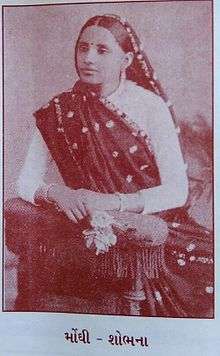Kalapi
| Sursinhji Gohil 'Kalapi' | |
|---|---|
 Sursinhji Gohil "Kalapi" | |
| Native name | સુરસિંહજી તખ્તસિંહજી ગોહિલ |
| Born |
Sursinhji Takhtasinhji Gohil 26 January 1874 Lathi, Amreli |
| Died |
9 June 1900 (aged 26) Lathi |
| Pen name | Kalapi |
| Occupation | poet, writer |
| Language | Gujarati |
| Nationality | Indian |
| Education | Std. 5 (English medium) |
| Alma mater | Rajkumar College, Rajkot |
| Period | pre-independance Gujarati literature |
| Genres | Ghazal, Narrative poetry, Metrical verse |
| Subjects | Love and Spirituality |
| Notable works |
|
| Years active | 1892 - 1900 |
| Spouse |
|
|
| |
| Signature |
 |

Sursinhji Takhtasinhji Gohil (Gujarati:સુરસિંહજી તખ્તસિંહજી ગોહિલ) (1874–1900), popularly known by his pen name, Kalapi (Gujarati:કલાપી) was a poet and the royal of Lathi state in Gujarat.
He lived in Lathi-Gohilwad, which is located in the Saurashtra region of Gujarat.
Life


Sursinhji was born to the royal family of Lathi in 1874. His mother's name was Ramba. He had a very short life of 26 years, and died in 1900. He was educated at Rajkumar College, Rajkot. He was married to two princesses. Rajba-Ramaba, the princess of Kutch - Roha, and Kesharba-Anandiba, the Princess of Saurashtra-Kotada at the age of 15. Ramaba was elder to Sursinhji by eight years, while Anandiba was elder to him by two years. When he was 20 years old, he fell in love with Shobhana, who was serving as a maid to his royal family.

It is believed that Kalapi's love for Shobhana became the reason of conflicts with Ramaba, and then the reason for his accidental death due to poisoning by his own wife.[1][2]
Works
In spite of his short life, poet Kalapi's creation was immense and enormous. His creation includes about 250 poems (including 15,000 verses). He has also given a number of prose writings. His 900 letters to his friends and wives brought the facts and truth. He not only used Gujarati language as his medium to elaborate his own creation, but also translated four English novels in Gujarati.
In his relatively short life, he still managed to mentor a minor number of budding poets, who carried on his style of writing, becoming very famous in their own right. The most prominent among these was Kavi Lalitji, who was about the same age as Kalapi, and already an established poet, when he was invited to the Lathi Darbar as a tutor for the Royal children. He came under Kalapi's influence, the two became great friends, and Kavi Lalitji went on to become the Rajya Kavi (Royal Bard) of Lathi.
All of Kalapi's creations, reading, study and achievements were packed by Kavi Lalitji during the period of his age from 16 years to 26 years.
Kavi Kalapi had written poems in various Chhand of Gujarati language. Like Mandakranta, Shardulvikridit, Shikharini etc. To write poem in particular Chhand, one has to follow the structure of that chhand and the rules of chhandas poem. Kavi kalapi is the only poet who has written maximum number of poems in these chhands.
Today, a museum has been set up in the present Lathi town, where visitors can gather more information about Kavi Kalapi's life and the history of Gohilwad Kingdom.
Kalapi award
In his remembrance, the Indian National Theater, Mumbai gives Kalapi Award to the established Gujarati ghazal poet annually since 1997.
In popular culture
The 1966 Gujarati film, titled "Kalapi" is based on his life, with Sanjeev Kumar playing the titular role, and Padmarani playing the role of his wife, Rama.
References
- ↑ Amaresh Datta (1988). Encyclopaedia of Indian Literature. 2. Sahitya Akademi. p. 1436. ISBN 978-81-260-1194-0.
- ↑ "Kavi Kalapi's birth anniversary celebrated". The Times of India. Jan 27, 2011. Retrieved July 1, 2014.
Other sources
- Milestones in Gujarati Literature by K M Jhaveri.
- Brahmbhatt, Prasad. (2003) Kavyasarita. (Literary Criticism of the evolution of Poetry). Ahmedabad: Parshwa Publication.
- Trivedi, Ramesh. M. (1994) Arvachin Gujarati Sahityano Itihaas. (History of Modern Gujarati Literature). Ahmedabad: Adarsh Prakashan.
- Trivedi, Ramesh. M. (2005) Gujarati Sahityano Itihaas. (History of Gujarati Literature). Ahmedabad: Adarsh Prakashan.
External links
- http://kavikalapi.com/timeline.php
- http://www.imdb.com/title/tt0264749
- http://www.marugondal.com/kalapi/index.htm